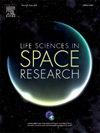Active radiation measurements over one solar cycle with two DOSTEL instruments in the Columbus laboratory of the International Space Station
Abstract
Two DOSimetry TELescopes (DOSTELs) have been measuring the radiation environment in the Columbus module of the International Space Station (ISS) since 2009 in the frame of the DOSIS and DOSIS 3D projects. Both instruments have measured the charged particle flux rate and dose rates in a telescope geometry of two planar silicon detectors. The radiation environment in the ISS orbit is mostly composed by galactic cosmic radiation (GCR) and its secondary radiation and protons from the inner radiation belt in the South Atlantic Anomaly (SAA) with sporadic contributions of solar energetic particles at high latitudes. The data presented in this work cover two solar activity minima and corresponding GCR intensity maxima in 2009 and 2020 and the solar activity maximum and corresponding GCR intensity minimum in 2014/2015. Average dose rates measured in the Columbus laboratory in the ISS orbit from GCR and SAA are presented separately. The data is analyzed with respect to the effective magnetic shielding and grouped into different cut-off rigidity intervals. Using only measurements in magnetically unshielded regions at low cut-off rigidity and applying a factor for the geometrical shielding of the Earth, absorbed dose rates and dose equivalent rates in near-Earth interplanetary space are estimated for the years 2009 to 2022.

 求助内容:
求助内容: 应助结果提醒方式:
应助结果提醒方式:


